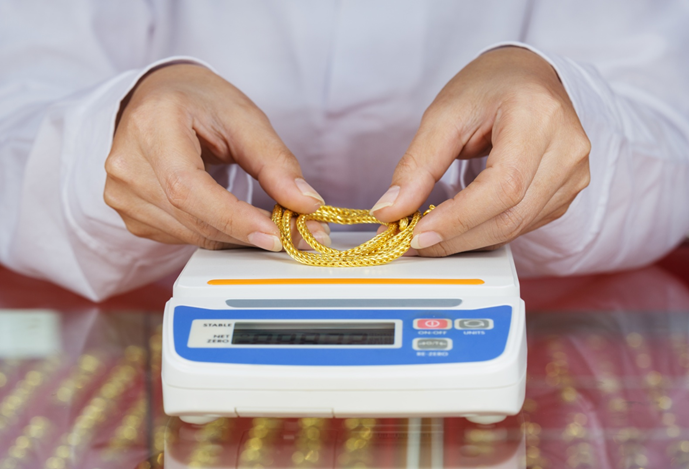
The Complete Guide on How to Tell if Gold Is Real
Online jewelry sales reached $7.6 billion in 2021 — and that’s just in the US alone. Gold is one of the oldest and most reliable currencies in the world, and selling gold is more lucrative now than ever before.
Who doesn’t want a piece of this pie? If you’re ready to take advantage of the gold market, it’s time to check your jewelry box. Your gold jewelry might be worth a mint, but only if it’s real gold.
Keep reading to learn how to tell if gold is real so that you can get yours on the market. Don’t let your golden goose sit around gathering dust — get what it’s worth today.
How to Tell if Gold is Real: Try a Magnet
The question “is gold magnetic?” has inspired countless science fair projects, not to mention endless internet debates. However, science has spoken. With the exception of rare science lab circumstances, pure gold does not react to magnets.
If your gold jewelry is 100% real gold — otherwise known as 24 karat gold — a magnet won’t be able to attract it. Many gold jewelry items are filled with other metals, including:
- Nickel
- Steel
- Iron alloys
These metals are magnetic. If your gold jewelry has an admixture of some of them, it will react to a magnet. On the other hand, pure gold won’t react.
This doesn’t mean that testing gold is as easy as grabbing your fridge magnet. Common magnets are too weak to attract the small amounts of magnetic metals in jewelry.
Instead, you’ll have to use a rare earth magnet. These super-strong magnets have the power to test your jewelry. Unlike the magnets on your fridge, they can attract even trace amounts of magnetic material.
Check for Karat Inscriptions
Check your gold jewelry for a karat inscription. These inscriptions look like stamps. You’ll find them hidden somewhere on your jewelry, probably:
- On the inside of your ring band
- On the clasp of your necklace
- On a tag attached to your necklace clasp
- On the underside of your pendant
Karat numbers refer to the purity of your gold. Gold karat inscriptions range from 8K to 24K. 8 karat gold has the lowest purity at only 33.33% true gold, and 24 karat gold is the purest available.
A bonus: knowing your gold’s purity gives you a big advantage when it comes to selling your gold. It’s easy to sell your gold locally through our friends at Gold Buyers Near Me, and knowing what to look for on your gold jewelry helps you sell it well.
Check for Other Inscriptions
The karat system is not the only way of measuring gold fineness. The millesimal fineness system is more common in Europe, and uses a system of three-digit numbers (sometimes with added decimal points) to describe how pure gold is. Check your jewelry for these inscriptions too.
In the millesimal fineness system, valid gold numbers include:
- 333
- 375
- 417
- 583
- 585
- 625
- 750
- 833
- 875
- 916
- 958
- 999
An inscription of any of these numbers indicates that your gold is real. The lower the number, the lower the gold purity. This means that if you see a valid millesimal inscription, you also know how pure your gold jewelry is.
Double-check the numbers. Other three-digit numbers, like 800 and 925, refer to silver purity instead of gold. If you see one of those numbers, your jewelry might be gold-plated silver instead of real gold.
Other Inscriptions
Finally, check for other inscriptions.
You might see words or letters, that refer to the jeweler or manufacturer. You can use these as a clue to figure out who made the jewelry. A high-quality manufacturer probably used real gold to make the jewelry.
Other letter inscriptions, like GP or GF, are bad news. They stand for “Gold Plated” and “Gold Filled.” They tell you right away that your jewelry isn’t real gold.
Check for Skin Discoloration
A piece of real gold jewelry won’t turn your skin green, black, or blue. Skin discoloration happens when cheap metals (like copper and bronze) react with the moisture of your skin. They oxidize and turn green, leaving dark smudges on your skin.
Real gold doesn’t react to your skin. Scientifically speaking, this is because it’s one of the most stable elements on the periodic table. When it comes to buying and selling, though, it just means that if you see any discoloration on your skin or your jewelry, you’ve got fake gold.
Look for Tarnish
For the same reason, gold doesn’t tarnish. You’ll have to clean your silver jewelry, but real gold doesn’t discolor over time. It may accumulate some grime on the surface, but the metal itself should stay brilliant and shiny.
Examine your gold jewelry for any discoloration. If there are any dark spots or areas of dullness, it might not be gold after all.
Do a Porcelain Scratch Test
For this test, you’ll need a piece of unglazed porcelain or ceramic. Gently scratch your piece of jewelry across the surface of the tile.
True gold will leave a light gold streak on the unglazed porcelain. If your jewelry leaves a black streak on the tile, it isn’t real gold. Be careful with this method, since it can scratch your jewelry and leave a permanent mark.
Get in on Selling Gold Now
The easiest way to start selling gold is to know its value. If you’re ready to cash in on your gold jewelry, the first thing you’ll need to know is how to tell if your gold is real.
With this article, you’ll be able to test your gold at home. Don’t rely on salesmen to tell you what your gold is worth. Test it at home with these tips so you know for yourself!
Was this article helpful? Don’t stop now. Keep reading our site to get more tips for buying, selling, and living well.
